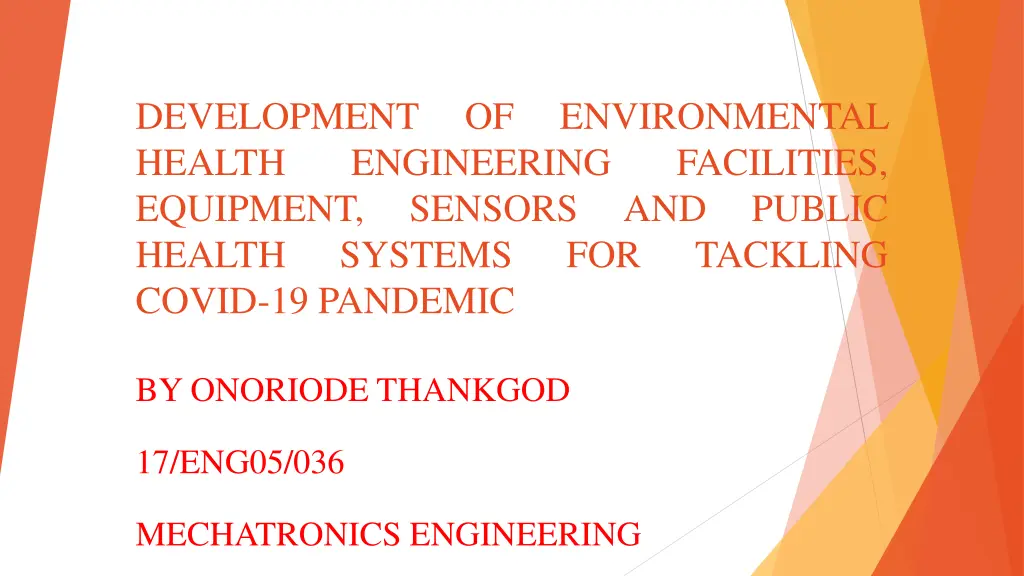
Tackling COVID-19 Pandemic Challenges with Health Equipment Development
Explore the impact of COVID-19 on public health and the urgent need for innovative health equipment like ventilators. Learn about the symptoms, transmission, and challenges associated with the virus, as well as the importance of engineering solutions for tackling the pandemic.
Download Presentation

Please find below an Image/Link to download the presentation.
The content on the website is provided AS IS for your information and personal use only. It may not be sold, licensed, or shared on other websites without obtaining consent from the author. If you encounter any issues during the download, it is possible that the publisher has removed the file from their server.
You are allowed to download the files provided on this website for personal or commercial use, subject to the condition that they are used lawfully. All files are the property of their respective owners.
The content on the website is provided AS IS for your information and personal use only. It may not be sold, licensed, or shared on other websites without obtaining consent from the author.
E N D
Presentation Transcript
DEVELOPMENT HEALTH EQUIPMENT, HEALTH COVID-19 PANDEMIC ENVIRONMENTAL FACILITIES, SENSORS AND SYSTEMS FOR OF ENGINEERING PUBLIC TACKLING BY ONORIODE THANKGOD 17/ENG05/036 MECHATRONICS ENGINEERING
COVID-19 is an acute respiratory illness caused by a novel human coronavirus (SARS-CoV-2, called COVID-19 virus), which causes higher mortality in people aged 60 years and in people with underlying medical conditions such as cardiovascular disease, chronic respiratory disease, diabetes and cancer.
The SARS virus, or severe acute respiratory syndrome, which first occurred in the Guangdong province in southern China. COVID-19 symptoms range from mild to severe. It takes 2-14 days after exposure for symptoms to develop. Symptoms may include: fever, cough and shortness of breath. The COVID-19 virus can be spread through contact with certain bodily fluids, such as droplets in a cough. It might also be caused by touching something an infected person has touched and then touching your hand to your mouth, nose, or eyes.
Those with weakened immune systems may develop more serious symptoms, like pneumonia or bronchitis. You may never develop symptoms after being exposed to COVID-19. So far, most confirmed cases are in adults, but some children have been infected. There is no evidence that children are at greater risk for getting the virus. Humans first get a coronavirus from contact with animals. Then, it can spread from human to human. Health officials do not know what animal caused COVID-19.
Ventilator machines mechanically move air in and out of a patient's lungs, keeping them alive when the patient s body can no longer do it on its own. Since the ventilators first usage in the 1950s, it has become a key medical device for hospitals, where startups continue to tackle this opportunity to come up with smaller and easier to use devices. Ventilators are crucial to fight the COVID 19, but they are in a huge shortage in the US. The ventilator to critical patient ratio is estimated to 1:10.
1. The current stockpile of PPE is insufficient, particularly for medical masks and respirators; the supply of gowns and goggles is soon expected to be insufficient also. Surging global demand driven not only by the number of COVID-19 cases but also by misinformation, panic buying, and stockpiling will result in further shortages of PPE globally. The capacity to expand PPE production is limited, and the current demand for respirators and masks cannot be met, especially if widespread inappropriate use of PPE continues.
2. Infection may occur at the skin entry site of the intravascular device, or in the subcutaneous path of the catheter (tunnel infection).It is considerably dependent on how lines are handled and duration of lines. Even peripheral lines are a potential source of line related infections.
3. Surgical site infections: Surgical site infections are also frequent: the incidence varies from 0.5 to 15% depending on the type of operation and underlying patient status. The main risk factor is the extent of contamination during the procedure (clean, clean contaminated, contaminated, dirty), which is to a large part dependent on the site of surgery, length of the operation, and the patient s general condition.
Administrative controls include ensuring resources for infection 1. prevention and control (IPC) measures, such as appropriate infrastructure, the development of clear IPC policies, facilitated access to laboratory testing, appropriate triage and placement of patients, adequate staff-to-patient ratios, and training of staff. Environmental and engineering controls aim at reducing the spread of 2. pathogens and the contamination of surfaces and inanimate objects. They include providing adequate space to allow social distance of at least 1 m to be maintained between patients and between patients and health care workers and ensuring the availability of well-ventilated isolation rooms for patients with suspected or confirmed COVID-19.
3. Wearing a medical mask if you have respiratory symptoms and performing hand hygiene after disposing of the mask; 4. maintaining social distance (a minimum of 1 metre) from persons with respiratory symptoms. 5.using PPE appropriately; this involves selecting proper PPE and being trained in how to put on, remove, and dispose of it.
CONCLUSION The development of environmental health engineering facilities, equipment, sensors and public health systems such as ventilators for tackling the coronavirus pandemic will help to quickly eradicate the spread of the virus.
